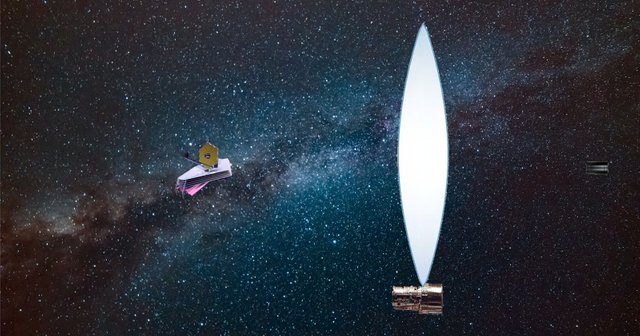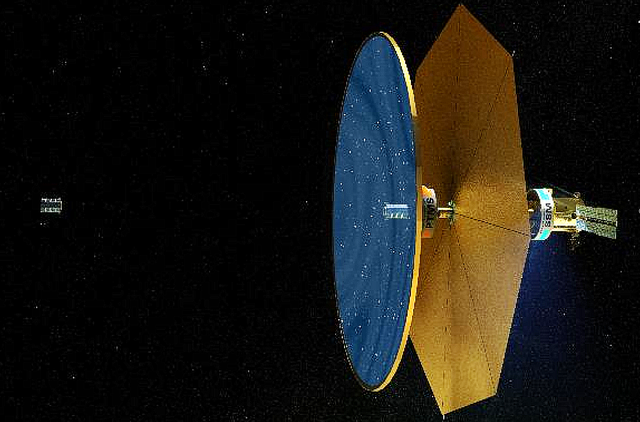NASA is already working on a telescope 100 times larger than James Webb/La NASA ya trabaja en un telescopio 100 veces más grande que el James Webb

Source
A little over a year ago, NASA launched the James Webb Telescope into orbit at a Lagrangian point a million and a half kilometers from Earth that offers unprecedented resolution and sensitivity, with a lens almost three times larger than that of the Hubble telescope but, once the bird has left the nest it's time to start thinking about the next innovation.
Hace poco más de un año la NASA ponía en órbita el telescopio James Webb en un punto lagrangiano a un millón y medio de kilómetros de la Tierra que ofrece una resolución y sensibilidad sin precedentes, con una lente casi tres veces más grande que la del telescopio Hubble pero, una vez que el pájaro ha abandonado el nido es hora de empezar a pensar en la próxima innovación.
And it seems that at NASA they have wasted no time and have been working on a new project called FLUTE, which consists of creating a fluidic telescope, which will be up to 100 times larger than the James Webb and which will be based on modeling of fluids, which allows large lenses to be built directly in space.
Y parece que en la NASA no han perdido el tiempo y han estado trabajando en un nuevo proyecto llamado FLUTE, que consiste en crear un telescopio fluídico, que llegará a ser hasta 100 veces más grande que el James Webb y que estará basado en el moldeado de fluidos, que permite construir grandes lentes directamente en el espacio.

Source
In theory, when we talk about telescopes, the bigger the lens, the more light it can collect, which makes it possible to see the most distant objects much more clearly, but this size has a limit that we have practically already reached if the lenses are manufactured on the ground, since that later we will have to take them into space, which greatly limits both their size and their weight.
En teoría, cuando hablamos de telescopios, cuanto mayor sea la lente más luz puede recoger lo que permite ver los objetos más distantes con mucha más nitidez, pero este tamaño tiene un límite que prácticamente ya hemos alcanzado si las lentes se fabrican en tierra, ya que luego tendremos que llevarlas al espacio lo que limita mucho tanto su tamaño como su peso.
But this is not an obstacle for NASA as it intends to build these lenses in space using liquids instead of glass, taking advantage of the way in which liquids behave naturally in microgravity environments, something that, although it is so novel, has already been proven. successfully on Earth in special facilities.
Pero esto no es obstáculo para la NASA pues pretende construir estas lentes en el espacio utilizando líquidos en lugar de cristal, aprovechando el modo en que los líquidos se comportan de forma natural en entornos de microgravedad, algo que aunque resulte tan novedoso ya se ha probado con éxito en la Tierra en instalaciones especiales.

Source
The researchers have previously tested building these liquid lenses on Earth by simulating a weightless environment with water, injecting a liquid that can solidify into circular frames submerged in water, allowing them to literally create lenses in a scrub bucket, like they have manifested.
Los investigadores ya han probado anteriormente la construcción de estas lentes líquidas en la Tierra simulando un entorno de ingravidez con agua, inyectando un líquido que puede solidificarse en monturas circulares sumergidas en agua, lo que les permitió crear lentes literalmente en un cubo de fregar, como ellos han manifestado.
In addition, it appears that the lenses obtained through this technology have a quality that rivals or even exceeds that of the lenses that can be created with the methods that exist in the manufacture of optical lenses and, since they do not have to be transported because they can be built in space, the allowable size limit is greatly increased.
Además, según parece, las lentes obtenidas mediante esta tecnología tienen una calidad que rivaliza o incluso supera la de las lentes que se puede crear con los métodos que existen en la fabricación de lentes ópticas y, dado que no hay que transportarlas pues se pueden construir en el espacio, el límite de tamaño permitido aumenta muchísimo.
More information/Más información
https://www.nasa.gov/directorates/spacetech/niac/2023/fluidic_telescope_flute/
Hola @mauromar, este telescopio sí que es gigantesco.
